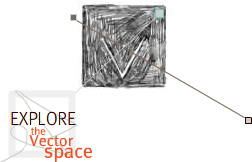Slavery's Ephemera
The Contemporary Life of the Antebellum Plantation
Design by Erik Loyer
Designer's Statement
Sometimes process reflects content in unexpected ways.
After having coded the algorithms for rendering the Mississippi river as it appears in this project, I set about writing some routines that would allow author Judith Jackson Fossett to place "sites" along the river--locations that could interact with our keywords as they floated downstream. The system I devised seemed simple enough: for each site, one could select whether it would appear on the east or west bank of the river, and then enter a number from 1 to 100 that would signify location: 1 would place the site at the top of the screen, and 100 would place it at the bottom. Numbers in between would place the site at some proportional location hugging the appropriate shore of the river.
Not an optimal interface, to be sure--it would be far preferable for Judith to be able to place the sites visually by dropping them directly on the river. Creating that interface, however, would involve spending valuable time on something that would be used only during one part the development process and then probably never again. The development of any sizable interactive project involves juggling trade-offs like this. I elected to go with the more indirect interface, tested the system briefly to make sure it was working as intended, and satisfied with the results, let Judith know it was ready for use.
Judith spent a significant amount of time trying to place all the sites, and then wrote me back and expressed frustration with the system. Apparently it was more difficult than I had expected to place the sites numerically; frequently they would overlap, and changing the placement by even one digit would cause unexpected jumps in distance. After some investigation, I discovered that the problem was not a bug in the system, but simply that the mathematical approach I had taken to placing the sites was unpredictable and inaccurate when paired with a numerical interface that required the user to work indirectly.
The landscape Judith portrays in "Slavery's Ephemera" is similarly an interface that requires its "users" to work indirectly--accessing an historical past through methods driven by the varied and sometimes contradictory influences of tourism, commerce, conservation, and the decaying artifacts of slavery themselves. Some of these influences promise transparent access to information and objects from the past; some promise experiences that attempt to place the user within that past; some make no promises at all. They are all indirect.
To solve the problem of how to place our sites along the river, I eventually had to go ahead and devise the visual interface I had initially rejected; direct visual juxtaposition of the elements involved proved to be the solution to the problem of accuracy. Similarly, Judith's direct juxtapositions of text, place and image help us to see this landscape for the conflicted, amnesiac palimpsest it truly is.



